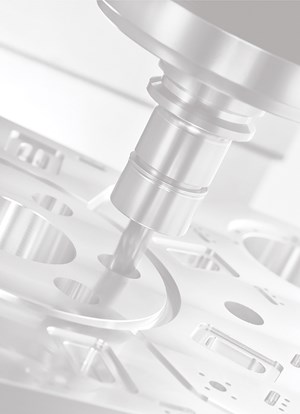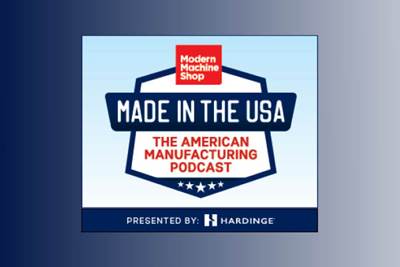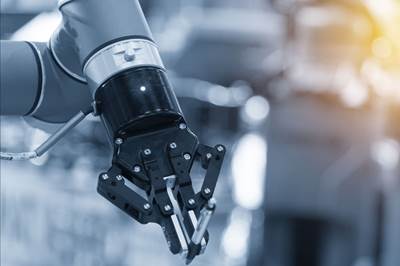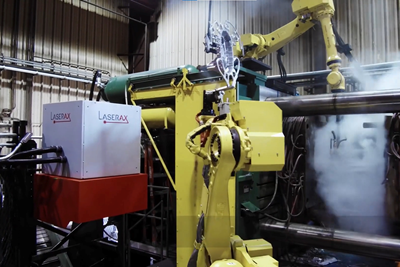-
-
SPONSORED
Robots and Automation in Metalworking
Machine-tending robots are often key components used to enable unattended or lights-out machining operations, adding capacity by taking advantage of time that’s currently unused, like nights and weekends. In many cases, robot integration enables shopfloor employees that were previously loading and unloading parts from machines to perform duties of greater value. Plus, today’s robots are faster and more intelligent than in years past and are also becoming increasingly viable for small-batch/high-mix production. In addition, collaborative robots, or “cobots,” use sensor technology that enables them function safely alongside humans in a shared work environment. That means no more isolating fencing is needed to separate worker and robot.



ESSENTIAL READING
VIEW ALL4 Manufacturing Trends That Cannot Be Ignored
The next five years will present their own unique set of challenges, and shops can alleviate them by embracing these technologies and trends.
Read MoreBlueprints to Chips: CAD/CAM Tips and Tricks
This collection of articles delves into the latest CAD/CAM innovations, from AI-driven automation and optimized tool paths to the impact of digital twins and system requirements.
Read More4 Steps to a Cobot Culture: How Thyssenkrupp Bilstein Has Answered Staffing Shortages With Economical Automation
Safe, economical automation using collaborative robots can transform a manufacturing facility and overcome staffing shortfalls, but it takes additional investment and a systemized approach to automation in order to realize this change.
Read MoreMade in the USA - Season 1 Episode 2: The Automation Puzzle
There is a fundamental question we need to answer when we talk about automation: To what extent is automation an answer to the skilled workforce shortage, and to what extent is automation vs. Skilled labor the wrong comparison to make in the first place?
ListenChoosing a Five-Axis Machine Tool With Automation in Mind
While much focus is placed on the machinery that moves parts, the features most important for automating five-axis machining are arguably found in the machine tool itself.
Read More5 Tips for Automating Laser Marking With Robots
Automating laser marking can be a useful way to increase robots’ utilization, but the process requires careful planning for success.
Read MoreLatest Automation News And Updates
Paperless Parts AI Tool Enhances Quoting Accuracy for Job Shops
Paperless Parts introduces Requirements Review, powered by Wingman AI, to surface critical requirements and streamline collaboration for faster, more confident quoting.
Read MoreThe Strategy Gap: Why U.S. Job Shops Must Close It From the Ground Up
The “Made in China 2025” plan transformed China into a global automation supplier. What will the U.S. do to compete?
Read MoreKassow Cobot Arm Technology Enhances Precision, Safety
Kassow Robots’ Sensitive Arm technology across its seven-axis cobot range enables advanced force control for delicate manufacturing tasks.
Read MoreUnited Machining Solutions' Wire EDM Supports Lights-Out Machining
United Machining Solutions’ Agie Charmilles Cut P 350 Pro features a robust design, the Uniqua human-machine interface and multiple automation options.
Read MoreRenishaw Gaging System Enhances Shopfloor Process Control
Renishaw Inc.’s Equator-X 500 dual-method system offers flexible measurement modes for high-speed inspection and quality assurance.
Read MoreSW North America Robot Cell Enhances Manufacturing Efficiency
SW North America’s Mobile S-Cell is a modular and mobile automation solution designed for flexible and scalable production across diverse manufacturing environments.
Read MoreFeatured Posts
Vertical Thinking: Strategies That Pay Off in Precision Manufacturing
How Marathon Precision’s mix of vertical integration, lights-out automation and cultural investment earned it a 2025 Top Shops Award for Business Strategies
Read MoreImplement Pallet Changers With a Customer-Centric Approach
Integrating pallet changers on the shop floor can have significant impact on part quality, service, price and on-time delivery.
Read MoreCAM Copilots and the Next Digital Shift in American Machining
As AI reshapes programming and automation, Mastercam is betting on a future where human expertise and intelligent software evolve together on the shop floor. A conversation with Mastercam President Russ Bukowski.
Read MoreWhat CNC Taught Us About Adopting AI in Manufacturing
Modern Machine Shop was early to cover CNC when others weren’t. Now, as AI pushes into programming, optimization and robotics, we need to separate production-ready tools from overpromised tech.
Read MoreWorkholding, ESOPs and AMRs: Building Midwest Job Shop Success
A to Z Machine’s True North mission statement defines an aim to become the best employer and supplier in the region. But what policies and technologies support this mission? From AMRs to Zero Point clamping, find out below.
Read MoreBlum-Novotest Competence Center Supports Lights-Out Automation
Blum-Novotest recently opened its new Competence Center in Erlanger, Kentucky. Inside, the company plans to run a training and technology hub for the U.S. market — especially supporting the growth of lights-out automation. Find out how below.
Read MoreFAQ: Automation
What is automation?
“Robot” is the first picture that comes to mind, but it means more than that. Automation could be machines that are able to do more in one setup, one handling. It also refers to other options like pallet systems for moving work around, in and out of machines. It refers to software that can automate certain operations. Automation is not a replacement or an alternative for people.
What is a cobot?
A collaborative robot or “cobot” is a robot that is safe to run unguarded near people. Most cobots are safe because they are speed- and force-limited, and they stop upon sensing contact with an obstacle. Cobots are also easy to relocate and reprogram for different tasks in a shop.
What should you know about cobots?
1. Cobots, vision and AI all go together.
2. Cobots do not guarantee safety.
3. Cobot applications need not feature collaboration.
4. Automation’s payback period is declining.
5. Trends in manufacturing favor collaboration.
6. Cobot adoption might be held back by lack of people.
7. Advancing AGV technologies make cobots mobile.
8. Attention recognition is coming.
9. Collaborative can be done in different ways.
10. “Collaborative” can be a bigger idea.
How do robots and 3D printing intersect?
1. 3D Printed End-of-Arm Tooling (EOAT)
2. 3D Printed Off-Robot Accessories
3. Robot-Tended 3D Printers
4. Robots As 3D Printing Systems































.png;maxWidth=970;quality=90)






 (1).png;maxWidth=300;quality=90)




.png;maxWidth=300;quality=90)


.jpg;maxWidth=970;quality=90)